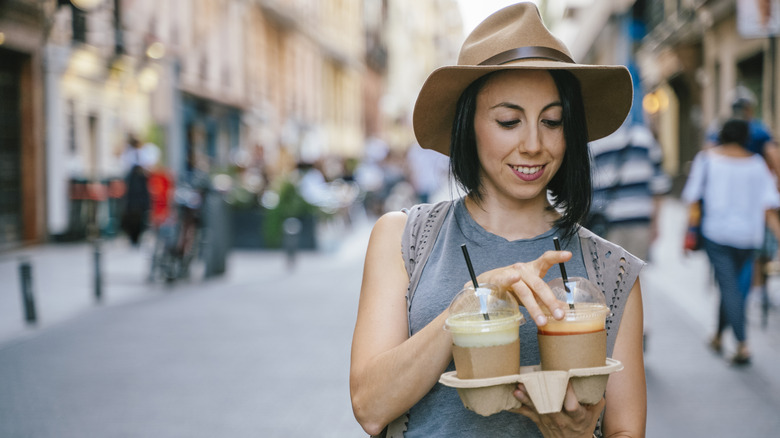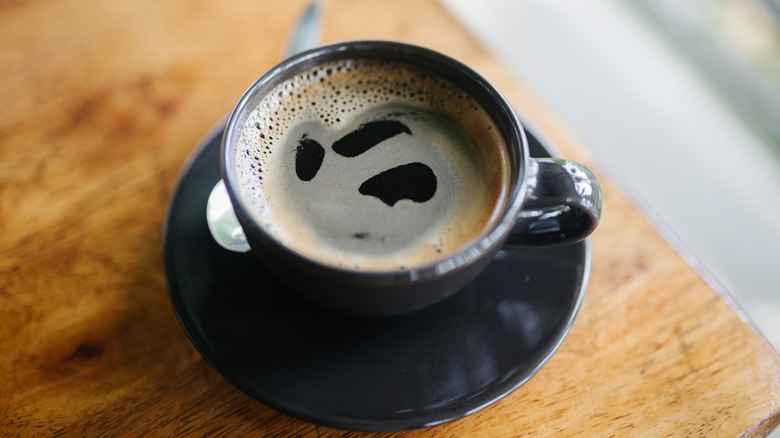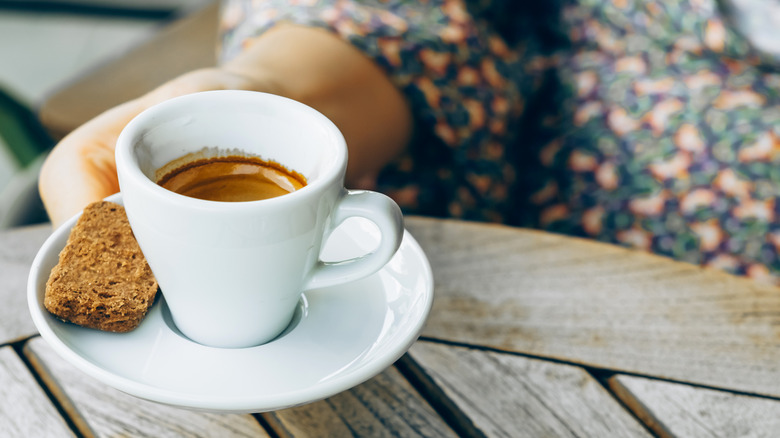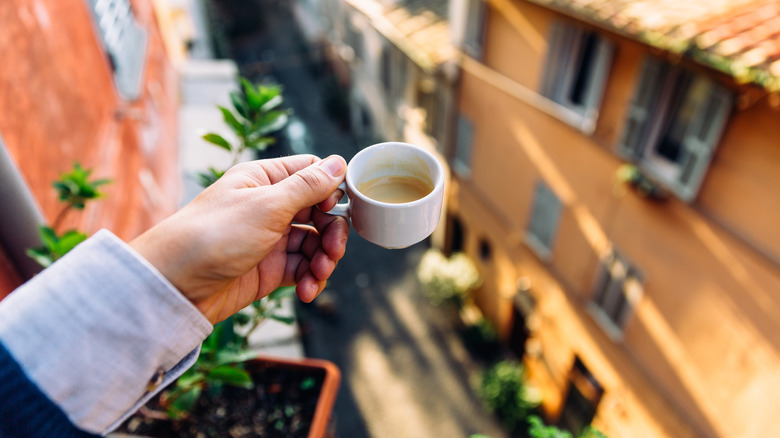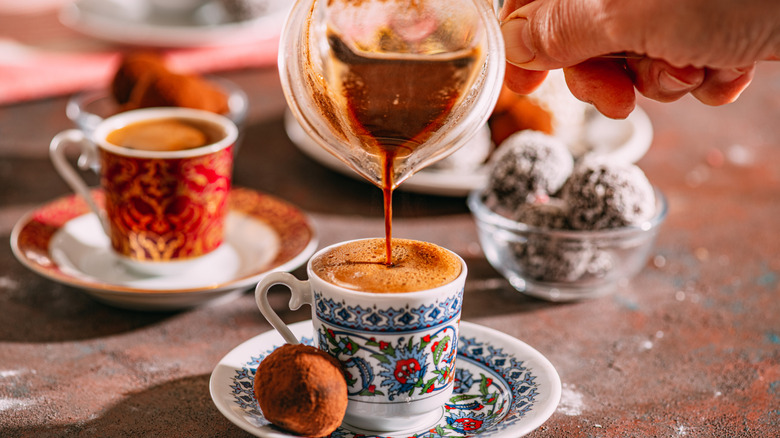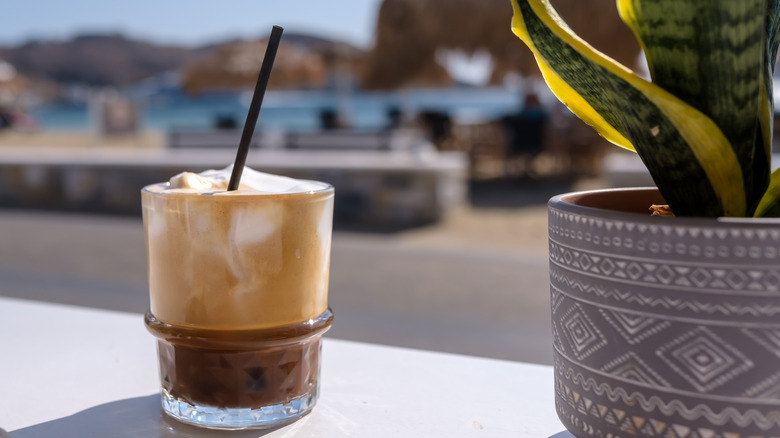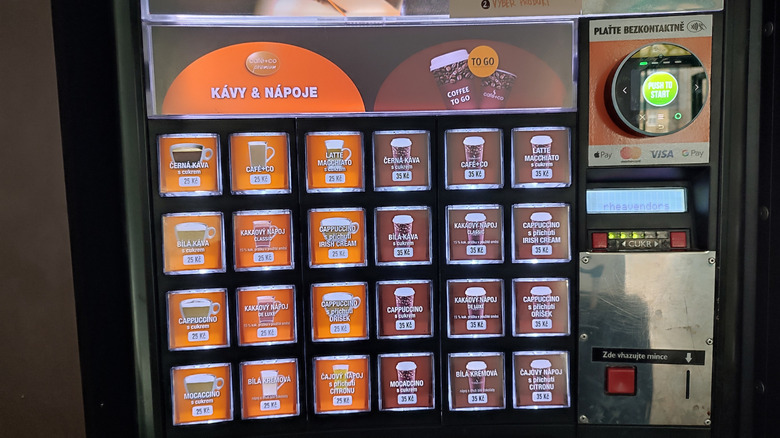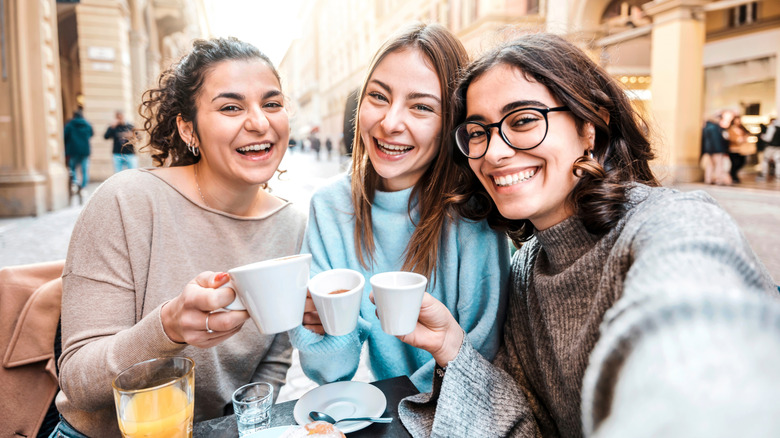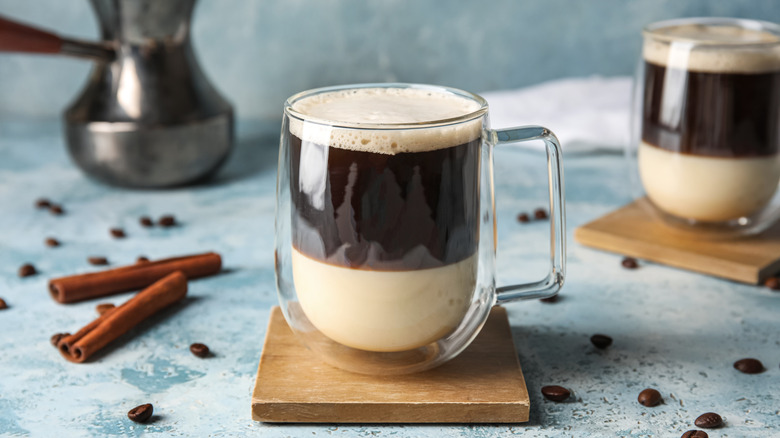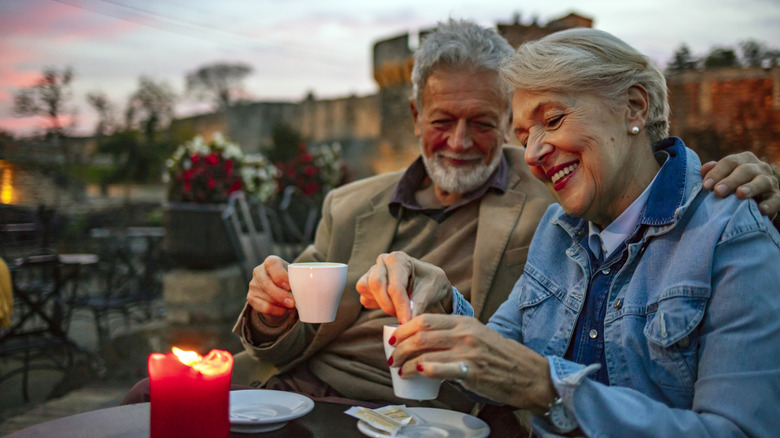How To Order Coffee In Europe Without Sounding Like A Tourist (And Get What You Want)
When vacationing in Europe, you might need that extra cup of caffeine boost to finish everything on your bucket list, especially if the coffee is an aspect of local culture you would like to explore. Indeed, each country in Europe has a distinct coffee culture, with unique names, preparations, and serving styles. Espressos originated in Italy during the early 1900s. France is revered for its vibrant roasts. Viennese coffee houses are historic marvels. Greeks love to refresh themselves with sweet iced coffees during the summer, and the Swedish famously enjoy their daily fika.
Of course, folks often come home from Europe saying that the coffee tastes better there, too. This may be partly due to the type of beans. European coffee shops frequently use a mix of Arabica and Robusta beans. Conversely, Arabica is favored more by the United States. The way the beans are processed and brewed also matters. Notably, Europe places a heavy emphasis on espressos, which are often consumed plain.
Indeed, drinking espresso is an economical way to get your caffeine fix in Italy. Espressos can also be modified to create another beverage, like a cappuccino. But by no means is all coffee across the pond espresso-based. This article will help you better understand the different types of coffee you can expect in Europe, as well as a few norms regarding how and when to drink it. That way, when you are finally seated at a quaint café with fabulous views, you can confidently get what you want.
Don't expect to find a freshly brewed pot of coffee
Although it is considered a staple at American diners, the quintessential pot of freshly brewed coffee might not be anywhere in sight at your neighborhood café in Europe. Instead, you can ask for an Americano, the watered-down version of an espresso invented to appease American soldiers' hankerings for drip coffee during World War II. The proportion of water to espresso in an Americano varies. Sometimes, you'll find it served in equal proportions, while at other times, you will receive two to three times the amount of water as espresso. In France, another option is to order a café allongé, which many folks equate to the Italian lungo. Both are long shots of espresso, meaning that their volume is much greater than what is offered by standard espresso shots.
If you are an Aussie or a Kiwi, you might be sorely disappointed not to find long blacks served in Europe. Yet again, an Americano may be your closest alternative. In an Americano, hot water is added atop the espresso, while in a long black, the espresso is poured on top of the water. This explains the difference between the two drinks: In an Americano, the crema, or froth, on top of the espresso dissipates when water is poured from above, which is not the case in a long black. Additionally, an Americano can have more water than long blacks and generally have a mellower coffee flavor.
Know the difference between a caffé latte and a café au lait
Now that we are solidly in the 21st century, most Americans are familiar with what a latte tastes like, or at least know that it exists and can be found at most coffee shops in the United States. It is widely debated where and when the lattes we all know and love today originated. Some say Seattle, Washington, during the 1980s, while others say Berkeley, California, during the 1950s. The name pays tribute to Italian coffee culture, though latte means milk in Italian. This is a good opportunity to note that because of this translation, you should always preface the beverage with "caffè" when traveling through Italy. If you don't say "caffè latte" in its entirety, you might just end up with a glass of milk.
A caffè latte is different from a café au lait. While the former is crafted with a single or double shot of espresso and twice the amount of steamed milk, the latter features equal amounts of brewed coffee and steamed milk. Additionally, the café au lait can trace its roots to France, not the United States, where caffè lattes probably originated, or Italy, where espressos emanated. Generally, if you prefer a stronger coffee flavor, opt for the café au lait.
Don't expect a mocha when ordering a mokka in Austria
Because moka pots are currently in vogue in the United States, you might already know that moka and mocha are not synonymous. Moka pots brew coffee by harnessing steam power to push water from a lower chamber through a funnel into an upper chamber. Along the way, this water comes into contact with coffee grounds, so by the time it reaches the moka pot's upper chamber, it has transformed into coffee. Moka pots derive their name from Mocha, a city in Yemen where you can get really great coffee. This city and the beans it exports also inspired the name of the chocolate-infused coffee drink we call "mocha." When you order a mocha in the United States, you will reliably be served an espresso and milk-based drink made more decadent by the addition of chocolate or cocoa powder.
However, neither moka pots nor mochas are what you can expect when you see "mokka" on an Austrian menu. Instead, you'll be treated to an espresso. The only caveat here is that you might be given a bit of cream and a glass of water to accompany it. Viennese coffee houses tend to be quite historic and grand, and while we fully encourage you to soak up their fancy vibes, it's worth doing a little more research into their menus ahead of time so that you don't feel intimidated.
Order the appropriate coffee for the time of day
If Americans have one complaint about Europeans, it's that they can be a bit snobby. While we acknowledge a tourist's autonomy and preferences, the complexity and traditions of Europe must be respected when on the continent. That said, you cannot order any coffee you want at any time of the day and expect the barista not to be taken aback. While you have the right to order and drink anything off the menu, many people find it more respectful to the local culture by abiding by a few time rules.
Namely, the time of day dictates the type of coffee you should order in Italy and France. In these countries, it is strongly suggested that you should only drink milk-based coffees in the morning. Cappuccinos, for instance, which feature espresso, steamed milk, and foam, are considered a breakfast coffee in Italy; in the afternoons, espresso reigns supreme. In France, café noisette, which consists of espresso and a splash of hot milk, should likewise be reserved for the morning hours. Another rule to keep in mind in France is that one should avoid eating food alongside coffee, except when it comes to breakfast. In this case, pastries are perfectly acceptable alongside a beverage like café crème or café au lait.
Know your milk options
Because of a rising interest in veganism and plant-forward diets, it is often feasible to source alternative milk like almond milk and oats from a well-stocked European grocery store. However, such options are far from universal, especially when it comes to traditional coffee shops and cafés. In many cases, you will be able to negotiate a different form of dairy. For instance, the default cappuccino in an Austrian café will often contain whipped cream instead of frothed milk, though you can still request the latter if preferred. In the end, your best bet for finding a coffee shop offering vegan milk is to hit up a chain like Starbucks.
That said, each country is different. In Germany, for instance, alternative milk is extremely popular. Therefore, you might be able to find non-dairy coffee options at some trendy, modern cafés, though the traditional spots will be more prone to solely offering cow's milk. To prepare for whatever culinary adventures lay ahead, consider stocking up on a handful of non-dairy creamers. This might mean carrying powdered coconut milk or little pods of creamer, like the ones you get on the airplane.
Don't equate Turkish coffee and Greek coffee
Greek and Turkish coffee are closely related, but calling them the same can be offensive. Greek coffee is prepared using finely ground coffee beans and a tall pot known as a briki. When you receive your order, don't be surprised if you find coffee grounds swimming in your cup underneath the layer of foam. They are meant to be there and will sink to the bottom as you let it cool.
Baristas often complement this bold, black brew with a heavy dose of sugar. Don't forget to specify how sweet you would like your coffee: sketos will get you an unsweetened cup; metrios, glykos, and vary glykos will get you semi-sweet, sweet, and very sweet, respectively. Similar to how you shouldn't expect to find flavored syrups in Italian coffee shops, don't try to get your Greek coffee sweetened with vanilla or lavender syrup; raw sugar is standard.
Like Greek coffee, Turkish coffee is a rich brew that features coffee grounds in the finished cup. However, Turkish coffee is brewed in a cezve, a small pot with a long handle. The Turkish version may also use more darkly roasted beans, rendering it slightly richer than its Greek counterpart. Plus, while not necessarily the norm, Turkish coffee can feature additional spices like cardamom and cinnamon. Try both beverages and see if you can tell the difference!
Be flexible when it comes to cold coffee
Many European countries can grow swelteringly hot during the summer, but not all have a robust iced coffee culture to match. For instance, it can be surprisingly difficult to find iced coffee on menus in Spain. Even so, at most Spanish cafés, you can still modify your order to get a beverage that will offer you sweet relief from the heat. Simply add the phrase "con hielo" to signal to your waiter that you would like a glass of ice alongside your order (in Valencia, the term to use is "del tiempo").
The story is rather different in Greece, where several cold coffees are popular among locals. The Freddo espresso, for example, is a beloved beverage in which baristas combine two shots of hot espresso with ice and sugar using an electric blender and metal canister. This equipment is necessary for achieving the ideal texture. Once the espresso becomes frothy, it is poured into a glass over ice. The Freddo cappuccino is similar but is topped with a sweet, creamy layer of milk (sometimes evaporated milk) that has been frothed. Interestingly, the cappuccino version evolves with each sip as the milk continues to meld with the coffee.
Be on the lookout for coffee vending machines
Vending machines stocked with all the makings for cappuccinos, lattes, and hot chocolate? Sign us up! You might stumble across a few of these while traveling through Europe, perhaps in public transportation hubs like airports, bus terminals, and train stations. While we mourn the absence of cultural interaction, such vending machines can be convenient, especially when you are in a rush.
Furthermore, they help break down the communication barrier since they frequently feature handy illustrations explaining the composition of each product. If that's not enough, you can always point your smartphone at the machine for Google Translate to give additional guidance on specific words. Some machines even come with customization features that, say, let you adjust how much sugar you want in your coffee. Plus, prices are straightforward, so there's no risk of accidentally overpaying for a drink you are not sure about in the first place. You don't even need to stress over whether tipping is customary.
Clearly, coffee vending machines offer plenty of benefits, but they also have one major downside: The flavor of your coffee will inevitably suffer when compared to what you would get in a shop. That's because many such machines use pre-ground coffee, and you would be lucky to come across a bean-to-cup vending machine that grinds the beans fresh. Like spices, coffee beans start to lose their aromatics upon grinding, so instant coffee and coffee powders will never be quite the same as freshly ground beans.
Explore the wonderful world of shakeratos
Shakeratos aren't exactly common in the United States, but you should have no trouble finding them in Italy during the summer. Composed of ice, sugar, and one or two shots of espresso, shakeratos are a popular antidote to the dog days of summer, which can approach 90 degrees Fahrenheit in many cities. As the name suggests, shakeratos are prepared with a fair amount of shaking. The three ingredients are vigorously combined in a cocktail tumbler before being poured into a glass (traditionally a cocktail glass) that you can sip elegantly while trying to ignore the sweat dripping down your back. All that shaking helps create a foamy layer that sits on top of the finished beverage; a bit of saline solution might also help in this regard.
Like cocktails, shakeratos can be upgraded to include other fancy ingredients like hazelnut liqueur, condensed milk, and smoked salt. This practice is certainly not standard, but you might find such variations on special menus or at particularly creative coffee shops. Additionally, shakeratos can differ in how they are sweetened; some baristas swear by raw sugar, while others prefer sugar syrup.
Don't ask for your coffee to go
Many Americans are accustomed to ordering from drive-through coffee shops. Coffee chains like Starbucks have such facilities nationwide, and the Pacific Northwest is home to a thriving coffee hut culture where even small businesses can get in on the action. However, you can't expect the same from Europe. Drive-through coffee shops are few and far between, and takeaway culture is not even the norm in many countries. Instead, the café experience is meant to be a gentle, relaxed affair where you can socialize with friends without the pressures of work. If you are a fan of "Emily in Paris," then you know what we mean.
For instance, it is considered poor etiquette to take your coffee "to-go" in France, and the majority of shops do not offer takeaway cups (chains like Starbucks notwithstanding). Plus, disposable cups have understandably come under fire for creating unnecessary environmental waste. A law has even been implemented in France to restrict restaurants and coffee shops from providing single-use cups and utensils. So, if you have tickets to an art museum closing soon or need time to freshen up for the opera that evening, ask for an espresso at the bar to save time instead. Or, you might bring your own reusable thermos. Just remember that takeaway is not the norm, so you shouldn't be surprised if you receive a few judgmental looks from locals.
Balance out Spain's bitter brews with milk
The Spanish love a strong brew, whether it's at home alone or in a public café alongside friends. Spanish coffee can be bitter due to the country's preference for Robusta beans and the fact that sugar is frequently burnt onto these beans. This roasting technique is known as torrefacto and was traditionally used to extend coffee beans' shelf life. As such, tourists often like to mellow down Spanish coffee with the addition of milk. The café con leche, for example, pairs equal amounts of espresso and scalded milk; it is creamy but not necessarily frothy. Meanwhile, the cortado combines espresso and steamed milk in a 1:1 ratio. It features a small amount of micro-foam.
For those who have been charmed by Spanish lattes and Vietnamese coffees, both of which feature condensed milk, the café bombón is a must-try dessert coffee when visiting Spain. Baristas begin making this drink by pouring sweetened condensed milk into a glass, then topping it with an equal amount of espresso and, if it's meant to be indulgent, a layer of whipped cream. Like several other Spanish coffees, the café bombón is served in a glass, allowing you to appreciate (and Instagram) its picture-perfect layers.
Ask for decaffeinated coffee if you want it
Late afternoon and evening coffees are commonly served in Europe. It's not rare for Europeans to savor a cup of coffee after dinner. If you find yourself in a social situation where everyone at the table has ordered coffee, but you are worried about it keeping you up all night, don't hesitate to ask for a decaffeinated option. Many restaurants offer it, as the demand for decaffeinated coffee is present even among Europeans. However, in some places, like Spain, you might only be able to get instant decaffeinated coffee, not freshly brewed. Being clear about your needs will help ensure you get the rest you need while on vacation — when those Z's might already be in short supply.
Decaffeination techniques usually result in beans that still have about 3% of their natural caffeine content, but that's not much to be worried about, especially when you consider that a single serving of dark chocolate can have double or triple the amount. To ask for a decaffeinated coffee in Italy, specify that you would like a decaffeinato. To ask for the same in France, the word to use is "déca." Café HAG is a common brand, but you might also be offered a caffè d'orzo or a cappuccino d'orzo. The latter two beverages are not coffee but are made from roasted barley.
